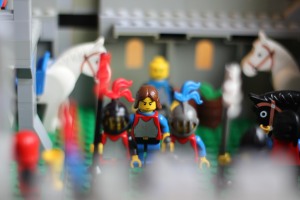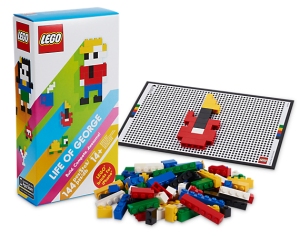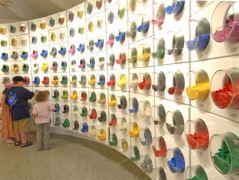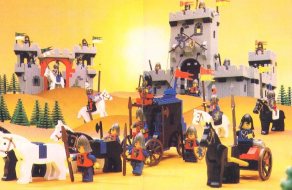This post continues the series of auto-ethnographic posts concentrating on my venture back into the world of LEGO at an adult age.
Well, I’m back from a long hiatus on updating my progress within the world of LEGO and I thought this would be a good time to share some pictures of the King’s Castle (6080) I finished already in January. I really loved building the set (for nostalgia, sure, but otherwise too). Here are some pictures of the finished set (enbiggenable to huge versions):
Ultimately I wasn’t able to replace some of the missing parts – some might notice this for example in the main tower of the castle. You can also see how some of the parts are really yellowed compared to others. While at first I might have been a bit upset about this, I soon realized that the mixing of different shades of grey (yes, even the newer bluish grey) gives castle builds a nice texture if you take the time to spread the different colored pieces evenly. Overall, I’m very happy how the castle turned out, and it really looks like the way I remember it looking.
Additionally, I only had a few of the parts and accessories needed for the original minifigs from the King’s Castle, so I had to create new ones. First of all, I only had one lion shield. Thinking about how to fix this little plot hole I figured that mine is a scenario where the lion knights, weakened by some conflict, have been forced to invite their enemies, the falcon knights, to the castle to negotiate some kind of a truce with them, a temporary one perhaps. Already, the new joint colors of red and blue have been raised (instead of the traditional red and yellow) and a scene of negotiation is going on. As I didn’t have more of the classic knight helmets, I had to create characters with hair pieces. Not having that many classic smiley faces, I also used a lot of newer faces ordered from Pick A Brick and many faces from the Kingdoms Chess set. With these I felt that the scene depicted well the reluctance of the lion knights to broker a peace with their age-old enemies and the arrogant pleasure of the falcon knights of things having gone this way (a future betrayal in their minds, no doubt). I was also very happy with the red haired character in the middle, who I imagined to be this Worm Tongue -kind of guy, having slipped into the ranks of the lion knights and being the chief architect of this plan through which the falcon knights now have gained access into the lion king’s fortress.
I was also pleased with some of the supporting characters, such as the ominous tower guard below, as I felt that his new face really nicely reflects his worn out chest armor. My old customized blacksmith found also a new home in the castle.
One of the most interesting aspects of the building process was tackling the missing pieces problem. Among other pieces, LEGO’s Pick A Brick service didn’t have the kind of prison doors originally used in King’s Castle, so I had to order a different kind of version. I had the original hinge pieces and I assumed that the hinge mechanic on the door would work the same way as it had on the original door. I was wrong. And, to my surprise, I first found myself completely lost when suddenly I didn’t have building instructions to follow. I simply couldn’t figure out how to create an alternative way to make to door work. Finally, one night as I was lying in bed, trying to fall asleep, a (super-simple) solution suddenly came into my mind, and I had to get up in the middle of the night to go quietly finish the door. Even a tiny solution like this made me really proud of myself and I’m sure many LEGO builders recognize this ‘A-ha!’ -moment to be one of the best things about LEGO building.


I also had to add a skeleton in the cell, plus some foreboding skulls and bones in front of the cell. Come to think of it, I’m not sure how these fit in the backstory of lion knights being the good and just rulers of the kingdom…
Having built the castle I realized something: I really like minifigs. I like them because of the roleplay/pretend play aspect they give. Creating characters and scenarios such as the ones on display in the above pictures really lights up my imagination and just…feels fun.
I’m now kind of sorry that, instead of the R2-D2 (10225), I didn’t get the Haunted House (10228) during the winter holidays. R2 is great, don’t get me wrong, but the decision to buy it was motivated too much on the fact that you could pose it nicely on a self for everybody to see, like a statue, same way as I imagine my AT-ST (10174) has worked for me. I wasn’t considering the minifigs. The minifigs, the minifigs. Scenarios. Scenarios with story. I love them. Much more than I love statues on shelves. Notably, minifigs and play sets have play value among each other – that is, they derive meaning from each other. Even if I won’t be pretend playing with the sets until I have kids, I actually kind of do that, only in my head, when I look at these castle and pirate sets. Creating these scenarios is shaping up to be a very interesting mix of creative building, storytelling and roleplaying, and something that I find to be a very appealing corner in the LEGO community. Having researched the community and its subgroups I really feel that I would like to be somebody who builds castle/pirate themed MOCs. From this perspective (and from subcultural research perspective) I’m really getting interested in the roleplay/play/build forums for castle MOCs, such as Guilds of Historica.






















